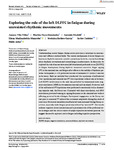Mostrar o rexistro simple do ítem
Exploring the role of the left DLPFC in fatigue during unresisted rhythmic movements
| dc.contributor.author | Vila Villar, Aranza | |
| dc.contributor.author | Naya-Fernández, Mariña | |
| dc.contributor.author | Madrid, Antonio | |
| dc.contributor.author | Madinabeitia-Mancebo, Elena | |
| dc.contributor.author | Robles-García, Verónica | |
| dc.contributor.author | Cudeiro, Javier | |
| dc.contributor.author | Arias, Pablo | |
| dc.date.accessioned | 2022-04-21T08:27:35Z | |
| dc.date.available | 2022-04-21T08:27:35Z | |
| dc.date.issued | 2022-04-16 | |
| dc.identifier.citation | Vila-Villar A, Naya-Fernández M, Madrid A, Madinabeitia-Mancebo E, Robles-García V, Cudeiro J, Arias P. Exploring the role of the left DLPFC in fatigue during unresisted rhythmic movements. Psychophysiology. 2022 Oct;59(10):e14078. | es_ES |
| dc.identifier.issn | 0048-5772 | |
| dc.identifier.uri | http://hdl.handle.net/2183/30518 | |
| dc.description.abstract | [Abstract] Understanding central fatigue during motor activities is important in neuroscience and different medical fields. The central mechanisms of motor fatigue are known in depth for isometric muscle contractions; however, current knowledge about rhythmic movements and central fatigue is rather scarce. In this study, we explored the role of an executive area (left dorsolateral prefrontal cortex [DLPFC]) in fatigue development during rhythmic movement execution, finger tapping (FT) at the maximal rate, and fatigue after effects on the stability of rhythmic patterns. Participants (n = 19) performed six sets of unresisted FT (with a 3 min rest in-between). Each set included four interleaved 30 s repetitions of self-selected (two repetitions) and maximal rate FT (two repetitions) without rest in-between. Left DLPFC involvement in the task was perturbed by transcranial static magnetic stimulation (tSMS) in two sessions (one real and one sham). Moreover, half of the self-selected FT repetitions were performed concurrently with a demanding cognitive task, the Stroop test. Compared with sham stimulation, real tSMS stimulation prevented waning in tapping frequency at the maximal rate without affecting perceived levels of fatigue. Participants' engagement in the Stroop test just prior to maximal FT reduced the movement amplitude during this mode of execution. Movement variability at self-selected rates increased during Stroop execution, especially under fatigue previously induced by maximal FT. Our results indicate cognitive-motor interactions and a prominent role of the prefrontal cortex in fatigue and the motor control of simple repetitive movement patterns. We suggest the need to approach motor fatigue including cognitive perspectives. | es_ES |
| dc.language.iso | eng | es_ES |
| dc.publisher | Wiley | es_ES |
| dc.relation.uri | https://doi.org/10.1111/psyp.14078 | es_ES |
| dc.rights | Creative Commons Attribution-NonCommercial-NoDerivs 4.0 International Licence (CC-BY-NC-ND 4.0) | es_ES |
| dc.rights.uri | http://creativecommons.org/licenses/by-nc-nd/4.0/ | * |
| dc.subject | DLPFC | es_ES |
| dc.subject | Fatigue | es_ES |
| dc.subject | Magnetic stimulation | es_ES |
| dc.subject | Neuromodulation | es_ES |
| dc.subject | Repetitive movements | es_ES |
| dc.title | Exploring the role of the left DLPFC in fatigue during unresisted rhythmic movements | es_ES |
| dc.type | info:eu-repo/semantics/article | es_ES |
| dc.rights.access | info:eu-repo/semantics/openAccess | es_ES |
| UDC.journalTitle | Psychophysiology | es_ES |
Ficheiros no ítem
Este ítem aparece na(s) seguinte(s) colección(s)
-
GI-NEURO - Artigos [158]







